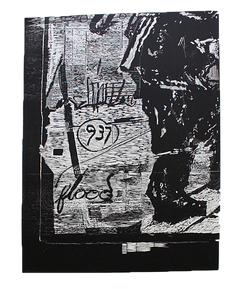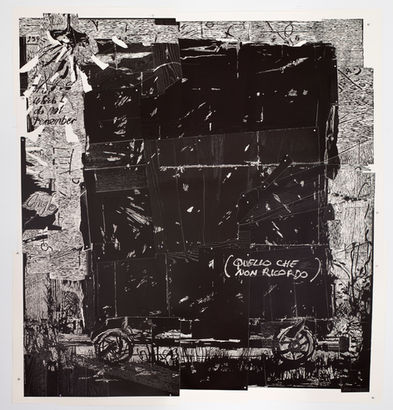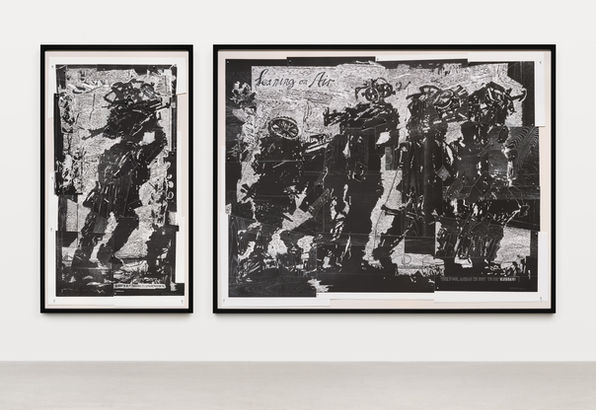Images courtesy the Kentridge Studio

.jpg)
Triumphs and Laments
William Kentridge
'This project, a frieze on the walls of the Lungotevere between Ponte Sisto and Ponte Mazzini, a distance of some 500 metres, was many years in the making. It was promoted, pushed and brought to fruition by Kristin Jones, who long had the idea and a wish for the bank of the Tiber river to be a space for public art. The work really started out of a sense of my own ignorance. I knew on the one hand, as we all do, of the glories of Rome – the Basilica of St Peter on the Trastevere side of the river – and I was also aware much later, maybe in my twenties, of the existence of the ghetto – the enclosed section for Jews on the other side of the river, about a kilometre down from St Peter’s. I had never thought of them as connected and I suppose it was a gap in my knowledge the that the establishment of the ghetto and the growth of St Peter’s had happened at the same time. What I had known of Rome was the great cathedrals, the glories of the Baroque and the starting shock of the project was that realization that the ghetto was actually a project of modernity. If you were to take a straight line from St Peter’s to the ghetto, it would more or less run straight through the section of the Tiber on which the work was done.'
'A plastic stencil was placed against the wall – suspended from the parapet at the top of the wall and pressed against the wall by people on ladders holding large brooms. Water from the river was pumped out, heated up and sprayed at pressure onto the stone and around the stencil, cleaning off the bacteria and pollution. The temperature, the pressure, the type of nozzle all controlled by the monuments commission and river authorities. Nothing was added to the wall. This was done in the knowledge that over a few years the images would fade away. The wall would darken again, through natural ageing, pollutants, graffiti; leaving a ghost of an image and a fading memory.'
Text courtesy the Kentridge Studio
Triumphs and Laments Woodcuts
David Krut Projects
Images courtesy David Krut Projects
In 2016, and for some years prior, William Kentridge was at work on a monumental frieze, called Triumphs and Laments: A Project for Rome, to be installed along the banks of the Tiber River. The work was designed to span 550 metres of an embankment of the river on Piazza Tevere: a procession of 55 drawings delving into the history of Rome from ancient times to the present, integrated with references to current world happenings, which open up conversations about the nature of history and how it is recorded; our capacity to remember, and to forget. For each drawing a stencil was created around which the surface of the wall was pressure-cleaned, leaving behind an image drawn in residue grime. As the natural environmental effects of pollution and bacteria amass once again on the wall, the images are erased.
In January 2016 Jillian Ross, Master Printer of Johannesburg’s David Krut Workshop (DKW), was invited to spend an afternoon in Kentridge’s Houghton studio. At the time, preparations for the frieze project were in motion, the walls and surfaces of the studio covered with proposed layouts, scale tests, preliminary drawings and plans. Ross and Kentridge began exploring the idea of using these drawings as the basis for a print collaboration.
A number of different avenues were investigated, and Ross left mulling over a few ideas. For Ross, an important considerations was the ability to build on the skills acquired in previous projects so as to go beyond what had been achieved before.
Film courtesy the Kentridge Studio and the David Krut Workshop.
Considering that the images stenciled onto the Tiber wall are ultimately fugitive, in time all that will remain of the project are the outcomes of collaborations that happened alongside and as a result of it. The Tiber River procession was an extraordinarily ambitious pursuit and the print collaboration needed to do justice to the scale and intent, albeit in a different arena. Woodcut was finally settled upon as the medium – a challenge in itself, having not worked together in the medium before. And so they embarked on a journey that led to the creation of a series of six almost-life-size, multi-sheet, multi-timber woodcut prints, which unfolded over the course of three years.
The Triumphs & Laments Woodcuts has been shown extensively, as a whole and in parts, over the course of the years in which it was made. 2019 saw two large-scale retrospective exhibitions of Kentridge’s work in Cape Town, at the Zeitz Museum of Contemporary Art Africa (MOCAA) and at the Kunstmuseum Basel
which presented the artist with an opportunity to review a selection of his work spanning the last 40 years. The Triumphs & Laments Woodcut Series was included in both these exhibitions as a pinnacle project for Kentridge in terms of his dedication to print media. The series, and its relationship to the Triumphs and Laments frieze project in Rome, is also an excellent acknowledgement of Kentridge’s dedication to impermanence and contingency in terms of making sense – of politics, of social commentary, of history.
Text by Jacqueline Flint, 2020
Courtesy David Krut Projects
Each print comes unassembled with the following contents included:
-
a black linen portfolio box that houses
-
an instructions manual
-
a booklet on the making of each artwork
-
-
the number of prints found in the finished work
-
the number of aluminum pins found in the finished work
-
two acetate sheets with registration notes (life size)


Images courtesy the David Krut Workshop
 |  |  |
|---|---|---|
 |  |  |
 |  |  |
Assemble The Flood by dragging and rotating the pieces below to resemble the finished art work.


























